Before I get into the details behind Chef Brock, his restaurant, and his cuisine, I'd like to share a little about McCrady's history. {2,4,5,7} Built in 1778, the building that houses McCrady's "embodies Southern glamour in a modern age." In fact, we were told that it was a tavern that George Washington had visited during his time. It is no surprise then that it is included on the National Register of Historic Places and Landmark. The tavernesque qualities of the restaurant's space, the toasty embers from the dining room's fireside, and the exposed brick along the walls gives its guests a warm (quite literally, too!) welcome into what will undoubtedly become one of the best meals of your life.
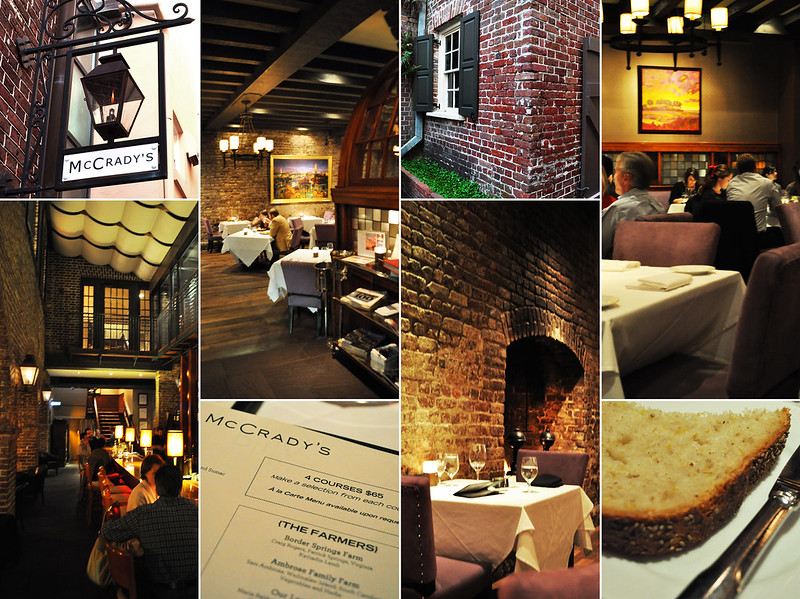
{7} The menu at McCrady's is very flexible -- you can opt for the nine-course tasting menu for $110 per person, the four-course prix fixe dinner for $65 per person, or simply a la carte to your liking. We were initially going to go for the tasting (there were a few courses on there that weren't offered with the other dining options), but seeing as there were four of us, we felt we could tackle more ground with variety than if we all opted for the tasting menu, ending up with the same nine courses all around. Musical dishes for sharing, woohoo! Additionally, I would like to note that the menu includes all of the farmers and purveyors that were used to source the ingredients for that evening's dinner, including Butcher & Bee, {8} which provided the artisan bread we had. Coincidentally enough, we had just eaten there for lunch that same day, not knowing we'd see them again so soon! I believe it was the same bread used in Alice's broccoli and brie grilled cheese sandwich. Such a tight-knit little place Charleston is! The bread you see here was a result of a six-month long collaboration between the kitchen at McCrady's and the team at Butcher & Bee. It is a ridiculously tasty and addictive multi-grain variety of oats with its loose crust dotted with benne seeds (which I recently discovered to be sesame seeds -- imagine that!). If I remember correctly, I had about three slices with a light smearing of salted, creamy butter. No shame!
Once seated, we were welcomed by Jodi, our energetic and super-knowledgeable captain (also a sommelier at McCrady's). If Chef Brock had a cheerleader, she would be the one -- she was so enthusiastic about our visit from New York City to Charleston (she is actually originally from Brooklyn!) that she gave us a very detailed rundown of the evening's menu -- you know, from an insider's as well as a fellow foodie's perspective. She knew the menu inside and out, down to the subtlest of ingredients and the preparation for some of the more complex items. Jodi was a blast to have throughout the course of our meal, and it was because of her fervor I became even more excited about the four courses that were to come.
Chef Brock grew up in Virginia, where his family grew their own food. "You grew and cooked everything you ate, so I really saw food in its true form," he has said. "You cook all day, and when you’re not cooking, you’re preserving. If you were eating, you were eating food from the garden or the basement–it’s a way of life." It was this way of life from his childhood that inspired a "lifelong passion for exploring the roots of Southern food and recreating it by preserving and restoring heirloom ingredients." He continued his relationship with cooking and studied at Johnson & Wales University in Charleston, and upon graduating, he began his professional career at the Peninsula Grill under Chef Robert Carter. He moved on to Richmond, Virginia where he worked in the kitchen of Chef Walter Bundy of Lemaire Restaurant and then to Nashville, Tennessee at the Hermitage Hotel as executive chef. After three years in Nashville, he returned to Charleston, accepting a position as executive chef at McCrady's Restaurant, where the restaurant's mission emphasizes "the importance of the food from the Lowcountry region and constantly refine its cooking processes to best honor its relationships with the farmers, artisans and fishermen that provide the restaurant with their amazing products." Its menu centers on "new Southern fine dining, concomitantly serving as a canvas for postmodern gastronomy" -- simply put, "inventive cuisine fresh from the farm."
One of his major projects upon his return to Charleston in 2006 included the development of a two-and-a-half-acre farm on Wadmalaw Island. During this time, Chef Brock "began dabbling in resurrecting and growing crops that were at risk of extinction, such as those indigenous to this area pre-Civil War." Crazy enough, this experimentation has made him "a passionate advocate for seed preservation" as he continues to grow a number of heirloom crops, Including James Island red corn ("Jimmy Red" for making grits), Flint corn, benne seeds, rice peas, Sea Island red peas, and several varieties of farro. In keeping up with this knowledge, he has also "worked closely with Dr. David Shields and Glenn Roberts of Anson Mills and studied nineteenth century Southern cookbooks to educate himself on Southern food history and discover new ways to resurrect antebellum cuisine." Further proof of Chef Brock's commitment to his trade and craft is his responsible sourcing of heritage breeds of livestock for his restaurants, including raising his own herd of pigs (some may call them heirloom pigs). Four years later, he opened Husk, his second restaurant, which focuses on classic cuisine of the Old South (which we also made reservations for the following evening).
And the laundry list of why Chef Brock is so commendable continues to grow. Being "a firm believer that 'low and slow' imparts the most flavor," he cooks food in the dining room fireplaces, which were actually built for this very purpose in the late eighteenth century. Chef Brock "believes cooking this way brings the historical building full circle." Additionally, he also pickles, cans, and makes preserves from the produce he cannot use immediately, saving it for a later date and for new creations. His techniques include an old Southern one called lactobacillus fermentation which uses his grandmother's forty-year-old vinegar as the base. For all of these reasons, it should not come as a shock that he has garnered awards and acclaim from the likes of the James Beard Foundation (winning "Best Chef: Southeast Region" in 2010; being nominated "Rising Star Chef" in 2008 and 2008 as well as "Outstanding Chef" in 2012), Bon Appetit, Food Network, Iron Chef: America, etc.

For our first course, we each chose four dishes from a set of five possible choices -- all recommended by Jodi that best showcased the region's bounty and ingredients. It was paired with a bottle of gruner veltliner (Hefeabzug -- German for "yeast-aged") produced by Nikolaihof from Austria with a 2011 vintage. {1} I had the sunchoke soup sprinkled with sunflower seeds and herbs along with {2} foie gras doughnut. Sunchokes are actually a variety of sunflower, so it has a very earthy and floral subtlety to it and was well-captured in Chef Brock's soup. It was incredibly rich and quite thick but not in the way that an overly creamy soup would be -- i.e., its thickness didn't lie in how creamy it was. It was magical and had the perfect consistency and washed over the palate intensely. The toasted sunflower seeds added an interesting textural contrast to the silky spoonfuls of soup. The foie gras doughnut was prepared almost as an ode to the zeppole as it was essentially fried dough, too, only with the essence of foie gras at its center. The bed of white crumbles was powdered sugar and dissolved into the dough with the slightest bit of heat from the soup. Ahhh, even now, I still want more of this soup!
{4} Marcus had the Masami Ranch wagyu beef tartare with beets, dill, and cabbage cream -- Chef Brock's loose interpretation of a soupless borscht (i.e., a soup typically made from tomatoes and beetroot). The beef was soft and chilly as you would want in a solid tartare. The coarsely chopped beets gave the beef cubes a little splash of raw juice, and the cabbage cream gave it more of a soup-like quality to it. {3} There was a side of grilled toast on which to enjoy the refreshingly hearty tartare. The addition of dill was a lovely touch.
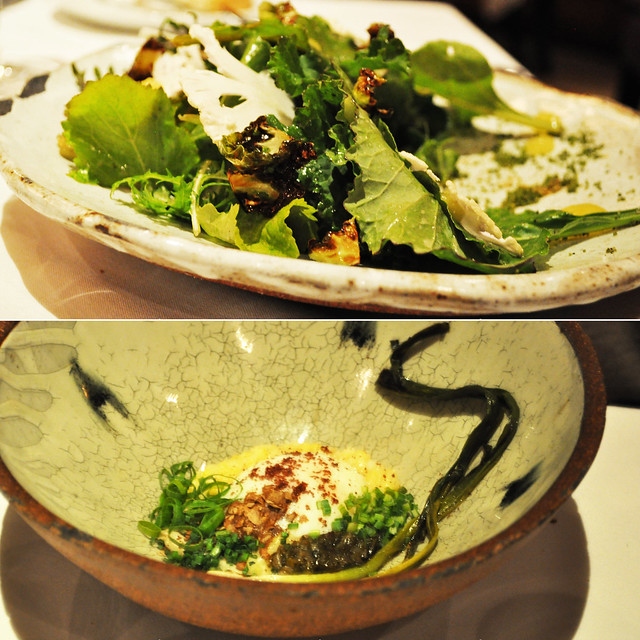
What's really interesting about many of the ceramic serviceware (plates/bowls/etc.) at McCrady's is that they are original creations that were custom made using the ashes from Husk's oven. Talk about quite the proverbial phoenix rising from the ashes!
{1} On one of these service pieces, Alice had the salad of winter brassica with cauliflower, citrumelo (also known as hardy grapefruit), and reine de pres (also known as meadowsweet). Brassica is a plant from the mustard family. If there's one thing Chef Brock is a wizard at, it's vegetables and crafting them into enchanting salads. Who knew salads could be magical? He curates the most vibrant and crisp leaves and the freshest vegetables, all lightly glazed with the most fittingly flavorful vinaigrette. The most bitter of leaves like the ones found in the salad of winter brassica (brassica is actually a genus of plants in the mustard family) were really appetizing and a pleasure to eat. If you want to see the potential behind the heirloom vegetables and plants native to the area/region (i.e., something you won't be able to find back in New York City), then order whatever salad Chef Brock has listed on his menus. I guarantee you'll be captivated.
{2} Jimmy went for the soft poached farm egg with Rosebank gold grits, farro miso crisp, allium, sumac, and leek jam. The egg itself was barely white and lightly translucent -- you know, the kind of consistency that could only form after a thoroughly slow and delicate poaching. Once pierced, the yolk washed over the creamy grits and the accompanying ingredients mixed in to create one dynamic bowl of awesomeness. The leek jam was so different than anything I had ever tasted before, and it made the entire dish sing a beautiful song of flavor.This was another dish with some grand Southern influence that can't be missed.
The next course that awaited us was the fish course.

{1} I had the stew of Lowcountry clams, oysters, and shrimp with benne, heirloom beans, kohlrabi, and lovage (i.e., from the parsley family). The bivalves were plump and rich in flavor (as they should be!), and the shrimp was divine. The lovage had a very strong taste of celery which blended well with the hearty and nutty flavors of the heirloom beans, kohlrabi (i.e., German turnip) and benne. Every part of this stew could be gobbled up and drunken to a clean-licked plate. Though less dressed up than the traditional French bouillabaise or Italian cioppino, this stew rang with Southern charm.
{2} Jimmy had the grilled cobia with roasted cabbage, turnips, and honeycrisp apple. The cobia was very meaty and dense -- the temperature of the cobia proved to be easy to eat and enjoyed accordingly. Its blackened exterior from the grill gave it an extra dimension of flavor to experience. The preparation seemed to be simple and yielded something grandly delicious. Overall, it paired well with the fall vegetables and refreshing slices of apple.
{3}Both Marcus and Alice opted for the pan-roasted tilefish with potato purée, braised chicken, and carrots. Each of them loved this course (I believe it was Alice's favorite of the evening, actually)! Its firm texture (though not as tense as the cobia) and clean taste was able to mesh quite favorably with the braised chicken that topped its thick, flaky filet, bringing some more intensity to the course overall. The potato purée was light and creamy, sweeping up the braising sauce from the chicken, and the carrots, while lovely for a pop of color in an otherwise brown-and-white dish, were delightful, too.
So I've changed my mind. Not only can he craft some kickass salads and make vegetables lively, Chef Brock just very well may be a fish whisperer in the realms of the kitchen.

For our meat course, we decided that a half bottle of red would do the trick. We went with another recommendation -- "Les Violettes," a grenache blend produced by Moillard from Côtes du Rhône, France with a 2010 vintage.
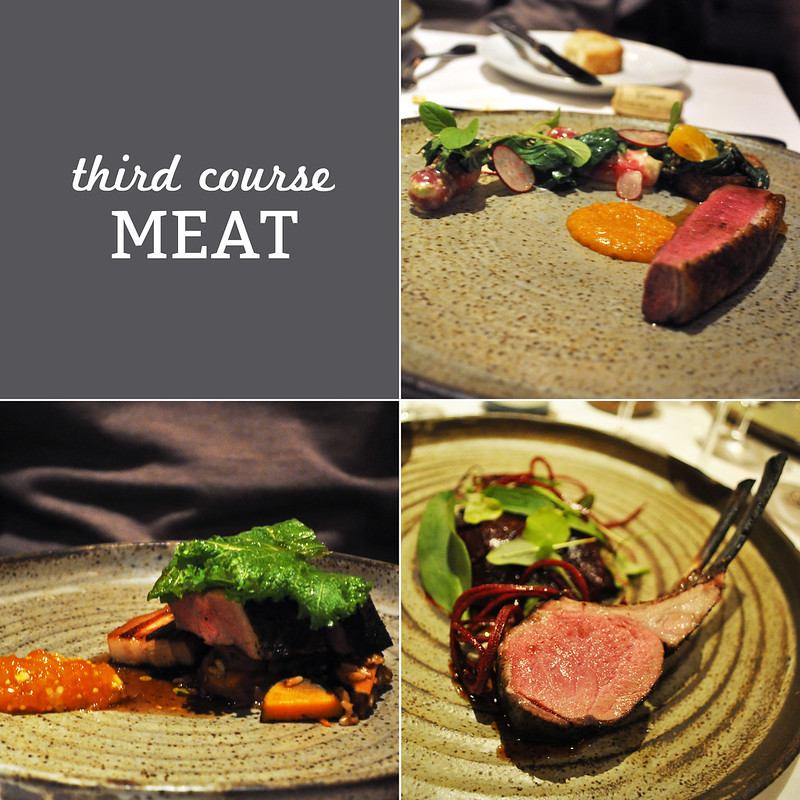
Many times, the meat courses at McCrady's is comprised of a duo -- i.e., two sections of the animal, prepared either in similar or different ways but somehow unify as a singular course. This is evident with the {2} duo of Berkshire pork (the belly and the shoulder) served with Japanese sweet potato, brewster oats, and pear mostarda (i.e., an Italian condiment made from candied pears and mustard-flavored syrup). Although Jimmy found a couple bites to be grisly, the pork was overall quite tender and flavorful. The pear mostarda had a jelly preserve-like texture to it and went perfectly with the cuts of pork (just like a fruit-centered chutney would). The brewster oats were also noteworthy in texture, rounding out the dish nicely.
{1} Alice had the aged duck roasted on the bone served with winter citrus, radish, and benne. How long was the duck aged, you may be wondering. Well, I'll tell you -- five whole days! The duck was exquisite -- roasted with an intense flavor from the bone with slightly smoky and texture of elegant tenderness (undoubtedly from the five-day agedness). An exercise in patience and commitment, those five days really make a hell of a difference! The winter citrus gave an interesting take to duck à l'orange especially with the tickled crunch of benne and snappy baby radishes. Outstanding!
{3} Another dual dish was the one I had -- the duo of Kathadin lamb (rib chop and shank) with cracked rye porridge, beets cooked in embers, and wild sorrel. The rib chop was cooked to a gorgeous medium rare, resulting in a succulent tenderness that absorbed all of the magical flavors from the surrounding bone and fat. It was easy to slice and to eat as well -- not one bit of this was grisly. I found myself gnawing away at the bone for any last charred remnants or bits of meat. The shank meat was mixed in with the side arrangement of smoky beets, fresh leaves of sorrel, and some rye porridge, showcasing another cut of lamb whilst highlighting some regional ingredients. Together, the duo of lamb made a winning dish.

Marcus had the Thornhill Farms chicken with chicken dumplings and Brussels sprouts. Jodi made sure to emphasize how important the chicken jus was to this dish, insisting that Marcus ask whoever would be presenting the course to pour the entire glass tube of jus onto the chicken. She was so serious, in fact, that she came out and did it herself! Something that my cousin Bill has noted to me before is how a main course that features poultry (especially chicken) can be a compelling way to assess how good a restaurant is or can be -- You know how you can tell a restaurant is really, really good? By how well its chef cooks its chicken course, especially the ones featuring chicken breast! If the kitchen can somehow manage to not turn it into a hard piece of inedible protein, but instead, yield a winning combination of moist, tender, and flavorful, then you can be sure they know what they're doing. In a world where chicken is so easily overdone and abusedm I am happy to report that McCrady's not only knows what the heck they're doing but also that they're doing something exciting with the chicken. The jus was crazy good and worth everything Jodi made it out to be. While the generous sliver of chicken breast was what one could only dream of having at least once in their life (like I said earlier -- moist, tender, and simply flavorful), the flavors were enhanced by the jus. The chicken dumplings were made style of German spaetzle dumplings and served loosely with the Brussels sprouts and herbs. While the dumplings were just okay, the Brussels sprouts were worth writing home about, especially with its exposed interior browned and edges charred.
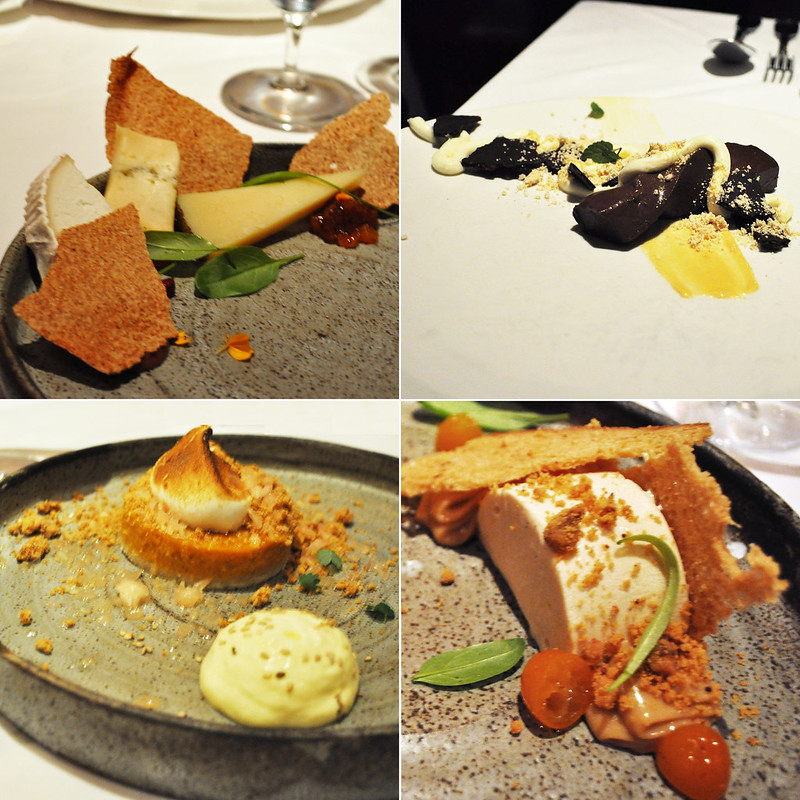
Each of us got a different dessert so we could play musical plates and sample them all. {1} Jimmy loves cheese so it was no surprise that he ended his four-course dinner with something a little savory: the chef's cheese selection of three artisanal cheeses. While Jimmy was enjoying his cheese plate, {2} Marcus was digging into the chocolate ganache with peanut butter, caramel, and mascarpone. I felt the presentation was lacking. When it arrived, all the elements of the dish seemed to be softened and nearly melted. But minus presentation, it was quite good and incredibly rich.
{3}I had the frozen brioche parfait with tamarind and kumquat. Very much resembling a baked Alaska (the swirl of toasted meringue is pretty gorgeous!), the frozen brioche was lightly sweet and mostly tart (most likely from the kumquats), resulting in a savory-leaning dessert. The parfait blended crumbly frozen brioche and had a light finish to the intense meal we had just devoured four-fold.{4} Alice went for the sweet potato pie with spiced anglaise, benne, and grapefruit. Another one for the savories, this spiced number was a deconstructed sweet potato pie with all of the fixings, including the restaurant's beloved benne. The main part of this dessert was very reminiscent of the creaminess of a cheesecake, and the crumbles of the "pie crust" went beautifully with it.
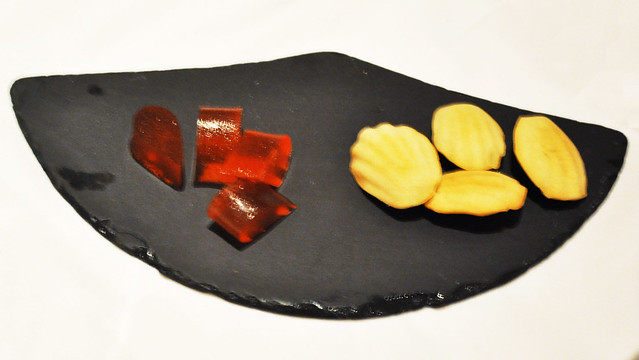
To end the meal, we were given a slate platter with two petit-fours -- a blood orange pâte de fruit and lavender-rosemary madeleines.
Findings: Our first evening in Charleston was marked by enchanted dinner -- one that involved the gusto and finesse of Southern cuisine at its highest potential, curated by the marveling Chef Sean Brock. The menu itself was a whole new game to tackle -- I learned a whole slew of new culinary nomenclature indigenous to the region. The chef's commitment to heirloom ingredients is definitely a large part of this enlightenment. One takeaway from everything we ate that evening -- the kitchen sure loves its benne seeds! And rightfully so -- it gives dishes that je ne sais quoi.
While I haven't had first hand experience with the tasting menu at McCrady's, I can certainly say that the four-course prix fixe menu offerings, especially if you're with a party of four, best showcases Chef Brock's culinary wizardry with much breadth. What would be key is to ask your captain for what they feel would be the signature dishes on the menu -- you know, the items that are most indicative of the South Carolina Lowcountry. I would say you couldn't go wrong with ordering any of the fish or meat dishes -- they were all lovely. At that point, it's just up to personal preferences -- the rest you can leave at the hands of Chef Brock!
All in all, I can boldly say that this meal at McCrady's shared with Marcus, Alice, and Jimmy, was one of the best meals of my life. I felt that familiar tingle in my bones when we licked up every last morsel on our plates, just as I had felt before over two years ago in Chicago after experiencing Chef Grant Achatz's modernist approach to fine dining at Alinea. This dinner was no different. It proved to me that Southern cuisine can be sophisticated, polished, and singular. Jodi shared with us that Chef Brock likes to think of McCrady's as "his head" -- where he does most of his thinking and innovating -- where as his other kitchen at Husk as his heart. If this is where his head is at, I wonder what Husk will have in store with what his heart holds.
So if you ever make it to Charleston, please make it a point to book a table at McCrady's. It is one of those things you must do for yourself. Just do it, and thank me later.
Price point: $65 per person for four-course prix fixe dinner, $68 for bottle of gruner, $24 for half bottle of grenache.
--January 5, 2013
McCrady's Restaurant
2 Unity Alley
Charleston, SC 29401
http://www.mccradysrestaurant.com

No comments:
Post a Comment